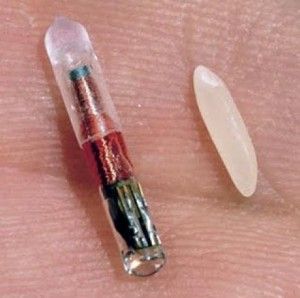 Lost pets show up at vets and shelters every day. If your pet goes missing, how will you be reunited? Properly identifying pets is an issue I'm very passionate about as a clinical practice veterinarian. I’ve helped lost pets reunite with their owners on innumerable occasions after good Samaritans brought in misplaced cats or dogs. In nearly every circumstance, these stray pets lacked tags and a collar. Fortunately this doesn’t mean the pet will be lost forever. An implanted microchip makes it more likely that your pet will be safely returned to you.
Lost pets show up at vets and shelters every day. If your pet goes missing, how will you be reunited? Properly identifying pets is an issue I'm very passionate about as a clinical practice veterinarian. I’ve helped lost pets reunite with their owners on innumerable occasions after good Samaritans brought in misplaced cats or dogs. In nearly every circumstance, these stray pets lacked tags and a collar. Fortunately this doesn’t mean the pet will be lost forever. An implanted microchip makes it more likely that your pet will be safely returned to you.
How do microchips work?
A microchip is about 12 mm long, approximately the size of a grain of rice. A thin layer of biocompatible glass coats the microchip, which significantly reduces the likelihood that your pet’s body will react with an inflammatory response such as swelling, pain, or itchiness. The microchip does not let off a detectable signal, but instead uses radio frequency identification (RFID) technology.
The microchip stores data that is interpreted by a microchip reader when placed within a few centimeters of the chip. If your pet gets lost and is found by a good Samaritan, he will likely be taken to a vet or animal shelter where the microchip will be scanned and a code is revealed. Once the code is known, the vet or shelter will contact the microchip. The manufacturer keeps a database with the pet owner’s personal information.
A microchip is implanted in the subcutaneous (fat) space between the shoulder blades for both cats and dogs. The process of administering a microchip is similar to giving a vaccination, but a larger 12-gauge needle is used. This causes some discomfort for the pet, which is why some veterinarians prefer to implant the microchip while the pet is under anesthesia for a surgical procedure like a spay or neuter. If your pet has already been fixed, plan for a microchipping procedure as soon as possible.
With my clients, I suggest microchip implantation during the initial veterinary wellness exam. I recommend asking your vet to complete the registration process so the chip is appropriately registered. Tell your vet if you need to update your contact info with the microchip manufacturer.
Many chips are equipped with anti-migration technology that helps prevent them from moving around the subcutaneous space to another part of the body. Although microchips are not supposed to migrate, sometimes they still do. The person scanning for a chip first checks between the shoulder blades. If there’s no chip detected between the shoulder, they’ll keep scanning other body parts including the front limbs, flanks, neck, and back of the skull.
Which microchip should my pet have?
It's important to discuss your pet’s lifestyle with your veterinarian to determine the most appropriate chip for implantation. Do you plan to keep your pet in the US or travel internationally with your pet? The International Standards Institute (ISO) chip would be better for globe-trotting pets. Common manufacturers of microchips include AVID and Home Again.
The World Small Animal Veterinary Association gives helpful information about the specifics of ISO chips in their Microchip FAQs page. Pets should always be thoroughly scanned for a microchip before one is implanted. There's no need for a pet to have more than one microchip unless less there is an issue with international travel requiring an ISO chip in the face of the previous chip being a non-ISO format.
Do microchips really help reunite pets with their owners?
Yes, according to the Journal of the American Veterinary Medical Association (JAVMA) article Characterization of animals with microchips entering animal shelters (July 15, 2009, Vol. 235, No. 2, Pages 160-167): The high rate for return of microchipped dogs and cats to their owners supported microchipping as a valuable permanent pet identification modality; however, issues related to registration undermined its overall potential.
Bundling of microchip implantation and registration, point-of-implantation data registration, use of annual compliance and update reminders, and providing access to all registries are potential solutions. Provided your information has been kept up to date, you can be contacted and reunited with your lost pet. Sometimes the microchip manufacturer doesn’t have the most current contact information for each pet, so the pet’s owner can’t be contacted. The pet’s owner will have to use the traditional means of finding the pet, including checking lost posters and calling local shelters and vets. A microchip is only helpful as long as your contact info is current.
Should I microchip my pet?
The best way for your lost pet to be returned to you is to give your pet as many forms of ID as you can. Make sure your pet has a microchip and wears a collar and tags with at all times. You can even embroider your pet’s name and phone number on the collar in case the tags fall off. Your pet’s tags and microchip should both have current contact info.






